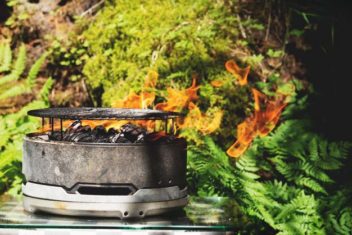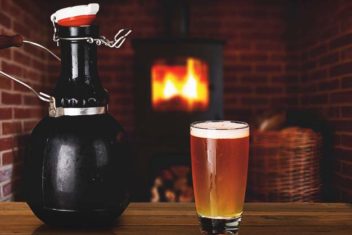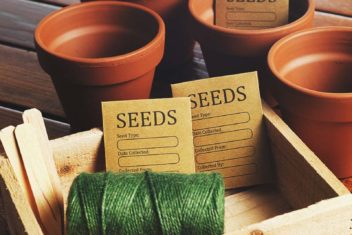When you have those branches in your garden you would like to cut, the best and most reliable equipment that plays the part without having to run the risk of breaking, or having to use too much energy is the lopper. They are far much better and more effective than a pruning saw or even pruning shears.
However, given the number of loppers available in the market, it can get quite confusing to know the right one to choose. I will provide a guide on what to look for when selecting one and a review of some of the best brands.
The 5 Best Loppers Reviews
- Fiskars 28-inch Bypass Lopper (Our Top Pick)
- Corona SL 3264 ComfortGEL Bypass Lopper
- Spear & Jackson 8290RS Razorsharp Heavy Duty Telescopic Ratchet Anvil Loppers
- Tree Power Lopper Tabor GL-18 Garden Bypass Pruner
- Tabor Tools GG11A 30-inch Bypass Lopper
Our Top Pick for The Best Lopper
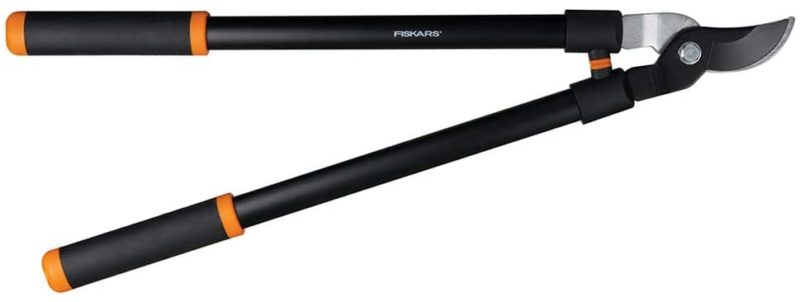
Our top pick for the best lopper is the Fiskars 28-inch Bypass Lopper.
This lopper is the best as it has the biggest cutting capacity. The cutting mechanism makes it so easy to cut through harder and thicker branches. Having long ergonomic handles is also a big plus for gardening enthusiasts.
Check the price on AmazonHow to Choose the Best Loppers
The first thing you will notice when looking at the different kinds of loppers in the market is that they come in different sizes, designs, and prices. Therefore, the kind of Lopper you will select for yourself should be determined by the exact kind of activity you will be doing, your strength, your body size, and also your budget constraints.
Type of Blade
There are basically two types of loppers blade; anvil lopper and bypass loppers. The kind of lopper you buy depends on the kind of pruning needs you have.
The Bypass lopper is the most common and are used by most people. They have two blades that glide past each other when you are doing the cutting. They provide a very clean cut – obviously depending on how well the blades are maintained. Using this kind of lopper is also advantageous to your plants as the smooth cut allows for the plants to heal much faster.
Their downside is that they get jammed when cutting dry or dead branches causing its blades to bend, and thus making them quite ineffective.
The Anvil loppers, on the other hand, have only one straight blade. They work like a knife and are very good for dead wood or trimming back live wood before using a bypass lopper to make a clean and final cut. They can handle much thicker branches as compared to the bypass loppers. Their mechanism is actually crushing the stem.
You should not expect a clean cut when you use the anvil lopper.
Blade Quality
Another aspect of the blade is its quality. The most preferred blades are those made of high-quality carbon steel that has been hardened to withstand the kind of force that will be exerted. These blades have a higher probability of lasting longer and have a lower likelihood of bending and the need for frequent sharpening.
The blade should be coated with a material that allows it to resist sap and any kind of sticky material should be flat and smooth, and should also look at how close the blades are together. Most loppers have the option of adjusting how close and tight the blades are together to give you room to adjust to your own specifications and preferences.
Cutting Mechanism
This aspect goes a long way in determining the amount of energy you will use. There are three kinds of action employed by most loppers; ratcheting, compound action, and geared.
The ratcheting loppers latch when you squeeze them, they allow you to release and squeeze again. This makes the cutting rather easy. The compound lopper has multiple moving parts and pivots. With the compound action lopper, you have to open it further to have the blades cover the branch entirely.
Geared lopper uses the gear mechanism providing more leverage when cutting.
Remember, the more parts and the more complicated a lopper looks like, the higher the likelihood of having difficulties when using it. I always like to think of keeping things simple.
Grip and Weight
The handles for the different loppers have been manufactured differently and uniquely. They come in different shapes and sizes. Some handles are made of soft material while others have contoured grips. The ones with the soft material can be comfortable but have a higher damage risk. The one with grips is a good option, but it may not be comfortable with some people.
The size of the grip is also important. Some may be too short, which can be limiting given the kind of work that one does with this equipment.
On the aspect of weight, consider a lopper that has a weight that you can comfortably handle and work with effectively. Heavy-duty lopper requires that they are made of steel which is much heavier, while lighter duties can still be handled effectively using a lopper made of aluminum.
Replacement Parts Availability
At one point in time after the lopper has been used for long, some parts will wear off and become ineffective. This will require that you either get a new lopper altogether or look for replacement parts. Getting a new lopper can be rather expensive. Therefore, right at the onset, consider getting yourself a lopper that has replacement parts available.
The availability of replacement parts also speaks much of the quality of the lopper. A high-quality lopper should have replacement parts available from the manufacturers themselves or the distributors.
Cutting Power to Weight Ratio
This is where the combined action and the effectiveness of the lopper come to play. The effectiveness of a lopper is determined by the weight and comfort of the lopper, the length of the handles, and the quality and effectiveness of the lopper blades.
When inspecting, or rather considering the power to weight ration of a lopper, consider its weight and relative power against your strength then ask yourself, if you can handle them comfortably. Lighter loppers are always a good option since you can use a pruning saw to handle the heavy branches and the lopper for the small and light ones.
In the case that the cutting capacity of the lopper is not sufficient, and the lopper is used to handle a rather heavier task, then you will be running the risk of spoiling the lopper rendering it completely ineffective. These are just but some of the considerations you could look into before buying a lopper.
I did a small survey in the market to determine the lopper brands available. I sampled out a few of the top brands and provided a brief review of the loppers and their features. So let us have a look at the loppers I have sampled.
Best Loppers for Pruning – Reviews
1. Fiskars 28-inch Bypass Lopper

The Fiskars 28-inch Bypass Lopper is specially designed to give you more cutting power for bigger tasks. This lopper can cut larger branches up to 1-½-inches in diameter with very little effort. Its fully-hardened stainless-steel blades have a low-friction, non-stick coating which provides smooth, clean cuts and stops the blades from getting stuck in the wood.
For your comfort, the durable steel handles feature soft, cushioned grips and the shock-absorbing bumpers eliminate any jarring. As the handles are extra long, you can cut hard-to-reach branches above your head. The blades are replaceable but they can be sharpened which means you do not have to open up the lopper entirely.
Fiskars offers a full lifetime warranty on their quality product if anything goes wrong with the lopper.
Pros
- Blades are super strong, and have great power, making it easier to cut bigger branches
- Durable steel handles feature soft, cushioned grips and shock-absorbing bumpers
- Works perfectly for all situations
- Fully lifetime warranty
Cons
- Blades can lose their edge quickly
- Some people prefer the older version (PowerGear 1)
2. Corona SL 3264 ComfortGEL Bypass Lopper
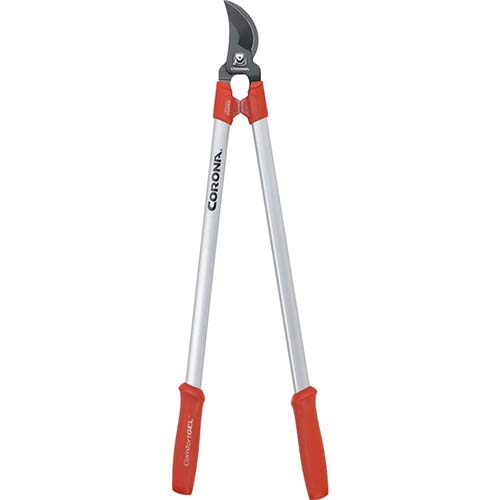
The Corona SL 3264 ComfortGEL Bypass Lopper is the ultimate equipment for pruning medium-sized and small trees. It offers a soft and comfortable feel in the hand allowing you to take full control. An impressive aspect of this lopper is the shock guard bumpers that reduce fatigue and strain when handling your pruning task.
The blades have a dual arc design that greatly enhances the lopper’s performance. The handles have grips, ergonomically shaped for maximum comfort and control. The handles are also made of steel, so you should not worry about the handles breaking.
Pros
- Nice lopper for its price
- Lightweight
- Handle is sturdy and the grips are comfortable
Cons
- Blades rust pretty fast
- Blades may chip easily
3. Spear and Jackson 8290RS Razorsharp Heavy Duty Telescopic Ratchet Anvil Loppers
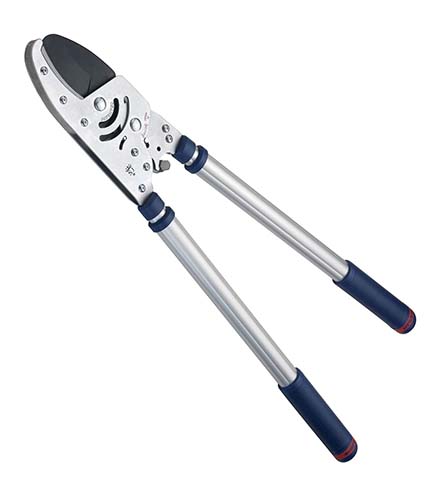
This Spear and Jackson 8290RS Razorsharp Heavy Duty Telescopic Ratchet Anvil lopper uses ratchet action that makes the cutting off of twigs and branches easy.
As its name suggests, it is suitable for handling rather heavier tasks; easily cuts branches that are thicker and harder blade’s performance is also impressive. The blade is made of carbon steel that is resistant to rust, hence, providing long-lasting sharpness.
The arm length when not extended is 18-inches and when extended is 32.5-inches.
Pros
- It can handle rather heavier tasks which make it convenient
- Long handle and the ratchet mechanism allows for use of less energy in cutting strong and thicker twigs and branches
- Handle is sturdy and the grips are comfortable
Cons
- Equipment weighs a lot making it uncomfortable to handle
- Handles may bend easily making its quality questionable
4. Tree Power Lopper Tabor GL-18 Garden Bypass Pruner
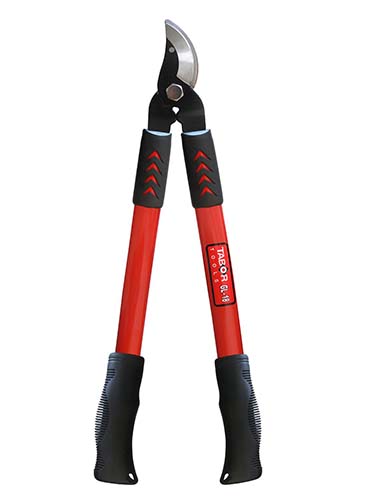
This Tree Power Lopper Tabor GL-18 Garden Bypass Pruner provides a clean-cut thanks to its blade designs.
The blades have a non-stick coating to reduce friction and make work much easier. The handles are small and fit just right in the hand; though this might not be very convenient in some circumstances. If you consider a case where you have to prune branches that are quite high, then it means you to get a stool or a ladder which is not convenient and can also be dangerous.
Cons
- Blades are effective enough and can cut through the branches quite smoothly
- Handles are comfortable thanks to the rubber covering which also provides a better grip
- Cheaper than the others, but still good
- Available in two sizes
Cons
- Might not be as strong as you would expect
- 20″ handle is awkward. 18″ or 25″ is much more comfortable in most situations
5. Tabor Tools GG11A 30-inch Bypass Lopper
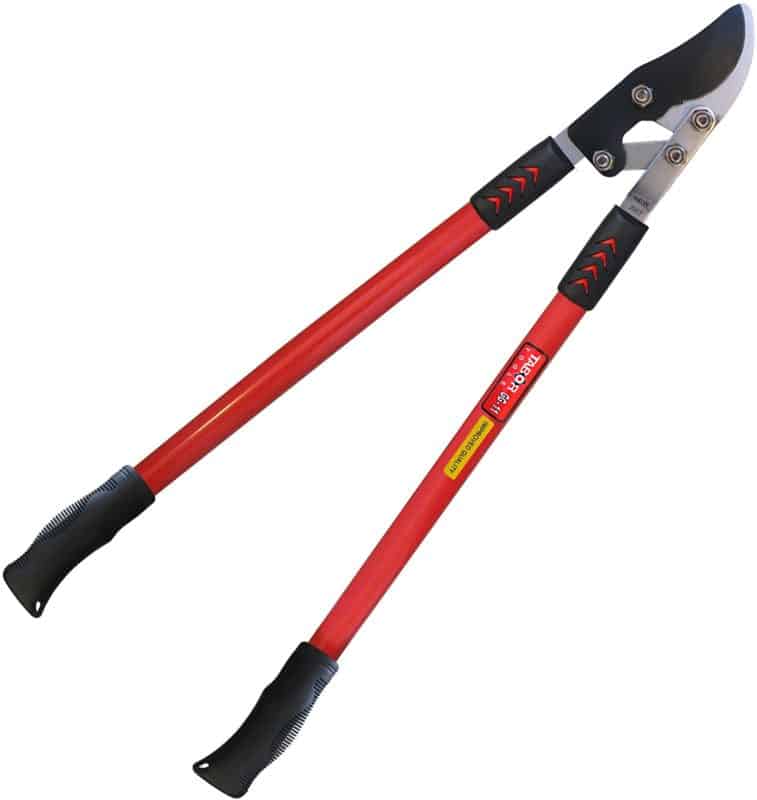
The Tabor Tools GG11A 30-inch Bypass Lopper is a high-performance tool that will help you to tackle tough jobs.
It is designed with compound lever action technology that optimizes your leverage and cutting power for thicker branches up to a 1¾-inch in diameter. The sturdy corrosion-resistant aluminum handles have ergonomic grips that allow for comfortable use. Reaching up to cut branches above your head is effortless due to the lopper’s extra-long 30-inch length.
The sharp carbon steel blades have a low-friction, non-stick coating that ensures a smooth, clean-cut and long-lasting durability. This lopper also has a well-balanced design that makes it ideal for any gardener.
Pros
- Very good high cutting capacity
- Comfortable to handle
Cons
- Lopper is a bit heavy
Our Top Pick for the Best Lopper

Our top pick for the best lopper is the Fiskars 28-inch Bypass Lopper
This lopper is the best as it has the biggest cutting capacity. The cutting mechanism makes it so easy to cut through harder and thicker branches. Having long ergonomic handles is also a big plus for gardening enthusiasts.
Check the price on Amazon
